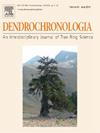滑坡研究中针叶树和阔叶树不同生长响应的方面
IF 2.7
3区 农林科学
Q1 FORESTRY
引用次数: 0
摘要
本研究探讨了两种树种杉木和冷杉对滑坡运动的不同反应及其对滑坡年代学的影响。这是中欧地区树木地貌滑坡研究中最常用的两种树种,一般建议将它们组合使用。然而,尽管它们是两个完全不同的物种,但它们对由此产生的年表的具体影响尚未考虑在内。该研究对位于girov本文章由计算机程序翻译,如有差异,请以英文原文为准。
Aspects of different growth responses of coniferous and broadleaved tree species in landslide research
This study investigates the differing responses of two tree species, P. abies and F. sylvatica, to landslide movements and their subsequent effects on landslide chronologies. These are the two most commonly used tree species in dendrogeomorphic landslide research in Central Europe and their combination is generally recommended. However, their specific effect on the resulting chronology is not yet taken into account although they are two quite different species. The research was conducted on 220 individuals of both species located in the Girová landslide area (Outer Western Carpathians), with a focus on the catastrophic event of May 2010. The study sought to understand how these species contribute to dendrogeomorphic reconstructions of landslide events, particularly by analyzing their growth responses and the frequency of growth disturbances (GDs) such as compression and tension wood. The results revealed significant differences in how P. abies and F. sylvatica responded to landslide activity. P. abies showed a higher frequency of GDs (compression wood), but exhibited greater inertia in its physiological response, potentially masking high-frequency landslide events. In contrast, F. sylvatica produced fewer GDs (tension wood), yet its response to landslides was more immediate and efficient, with 100 % intensity in tension wood formation, which helped create a minimum-noise chronology despite fewer identified events. The study highlights the advantages and limitations of both species in dendrogeomorphic research. While P. abies contributes more frequently to detecting landslide events, the inertia in compression wood formation can complicate the interpretation of rapid landslide movements. On the other hand, F. sylvatica, though less responsive in terms of GDs, provides a clearer and more precise landslide chronology. Future research should explore the physiological factors behind these species' different responses to enhance the accuracy of dendrogeomorphic reconstructions.
求助全文
通过发布文献求助,成功后即可免费获取论文全文。
去求助
来源期刊

Dendrochronologia
FORESTRY-GEOGRAPHY, PHYSICAL
CiteScore
5.50
自引率
13.30%
发文量
82
审稿时长
22.8 weeks
期刊介绍:
Dendrochronologia is a peer-reviewed international scholarly journal that presents high-quality research related to growth rings of woody plants, i.e., trees and shrubs, and the application of tree-ring studies.
The areas covered by the journal include, but are not limited to:
Archaeology
Botany
Climatology
Ecology
Forestry
Geology
Hydrology
Original research articles, reviews, communications, technical notes and personal notes are considered for publication.
 求助内容:
求助内容: 应助结果提醒方式:
应助结果提醒方式:


